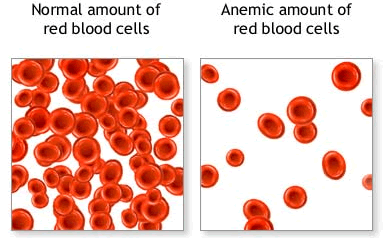By
Liz Highleyman
Anemia is a common
side effect of treatment for chronic
hepatitis C virus (HCV) infection, due to red blood cell
destruction (hemolytic anemia) caused by ribavirin and bone
marrow suppression related to interferon.

Erythropoietin
(Procrit) and other erythropoiesis-stimulating agents (ESAs)
that boost red blood cell production may be used to manage anemia.
Reducing the dose of ribavirin is also done to control anemia,
but this may increase the risk of post-treatment relapse, and
therefore decrease the likelihood of achieving sustained response.
Mark Sulkowski and fellow investigators looked at the relationship
between treatment outcomes, anemia, and use of ribavirin dose
reduction and ESAs among participants in the IDEAL trial.
As
previously reported, IDEAL compared 180 mcg/week pegylated
interferon afa-2a (Pegasys) plus 1000-1200 mg/day weight-adjusted
ribavirin versus 1.0 or 1.5 mcg/kg/week pegylated interferon
alfa-2b (PegIntron) plus 800-1400 mg/day ribavirin in more than
3000 previously untreated genotype 1 chronic hepatitis C patients
at 118 U.S. sites. Participants who received Pegasys had a higher
end-of-treatment response rate, but those taking PegIntron had
a lower relapse rate, so SVR rates ended up about the same.
IDEAL participants who developed anemia -- defined as a hemoglobin
level < 10 g/dL -- first had their ribavirin dose reduced
and then were permitted to use ESAs if this was not sufficient.
In the present analysis, investigators analyzed sustained response
rates according to decreases in hemoglobin, anemia, and ESA
use. A total of 3023 patients had their hemoglobin levels measured
at least once during treatment.
Results
 |
865
participants (28.6%) developed anemia during treatment. |
 |
449
of these patients (51.9%) used ESAs, usually after ribavirin
dose reduction. |
 |
Patients
who developed anemia were significantly more likely to achieve
sustained virological response. |
 |
SVR
rates were associated with magnitude of hemoglobin decline:
|
 |
Drop
of > 3 g/dL: SVR 43.7%; |
 |
Drop
of < 3 g/dL: 29.9%. |
|
 |
Participants
who reduced their ribavirin dose were not significantly
less likely to achieve SVR. |
 |
Among
patients with early-onset anemia (through week 8 of treatment),
those who used ESAs had a significantly higher SVR rate
than those who did not (45.0% vs 25.9%). |
 |
People
with early anemia who used ESAs were also significantly
less likely to discontinue treatment due to adverse events
(12.6% vs 30.1%, respectively). |
 |
However,
ESA use did not affect SVR or treatment discontinuation
rates among patients who developed anemia after 8 weeks. |
"Among
HCV genotype 1-infected patients treated with [pegylated interferon/ribavirin],
anemia was associated with higher rates of SVR," the study
authors concluded.
"The effect of ESAs varied by time to anemia," they
continued. "[P]atients with early-onset anemia had higher
rates of SVR with ESA use, whereas no effect was observed in
those with late-onset anemia."
Importantly, the likelihood of HCV relapse did not increase
among patients who decreased their ribavirin dose, in constrast
with some prior research.
These
findings "firmly underscore the recommendation for [ribavirin]
dose reduction as the primary strategy for management of treatment-related
anemia," before using ESAs, the researchers wrote. They
added that, "ESAs should not be used solely to avoid [ribavirin]
dose reduction in anemic patients."
Investigator affiliations: Johns Hopkins University School
of Medicine, Baltimore, MD; Bon Secours Health System, Liver
Institute of Virginia, Newport News, VA; Beth Israel Liver Center,
Boston, MA; University of Pennsylvania Health System, Philadelphia,
PA; Mount Vernon Endoscopy Center, Alexandria, VA; University
of Texas Southwestern Medical Center, Dallas, TX; Thomas Jefferson
University, Philadelphia, PA; Brooke Army Medical Center, Fort
Sam Houston, TX; Cedars-Sinai Medical Center, Los Angeles, CA;
Schering-Plough Research Institute (now Merck & Co), Whitehouse
Station, NJ; Duke Clinical Research Institute, Durham, NC.
1/11/11
Reference
MS Sulkowski, ML Shiffman, NH Afdhal, and others (IDEAL Study
Team). Hepatitis C virus treatment-related anemia is associated
with higher sustained virologic response rate. Gastroenterology
139(5): 1602-11 (Abstract).
November 2010.
Other
Source
Reuters
Health. Anemia in treated-HCV patients bodes well for sustained
virological response. December 12, 2010.
